An oilfield service company located in Suriname started operating its second hoverbarge-based swamp drill rig, Toucan II, this year. Their first hoverbarge-based swamp drill rig (Toucan I) began working in 2006 in the swamps of Suriname. The Toucan I is a 170 x 90-ft monohull design with a 330-ton payload powered by four diesel engines. The Toucan II is a 140 x 110 ft unit with a 300-ton payload and is powered by two diesel engines. The Toucan II is built on a platform using the company’s modular steel Flexifloats, individual pontoons that join together to make up a larger platform. With the modular design, unlike the monohull, if the contractor needs to access an area where the hoverbarge cannot be towed, for example, a different part of the country, the barge can be disassembled and trucked overland to the next wellsite and then reassembled. Because the unit is amphibious, it can be used on dry land as well as in swamps.
The unit does not include a permanent derrick or mast and power equipment. A truck-mounted rig or workover unit is used on the platform and drills or performs workover work through a keyway. The covered keyway extends from the stern to the end of the substructure, allowing the barge to move over existing wellheads for workover work as well as to install wellheads for new wells.
Previous to using the hoverbarges for swamp drilling, the contractor was averaging a lower number of wells drilled, the result of significantly longer time expended mobilizing traditional swamp rigs that had to be dragged from wellsite to wellsite. Since the addition of the hover drillbarge, the number of wells drilled have increased significantly. The hoverbarge is not self-propelled but it does provide lift via fans on each corner of the platform. The unit hovers 4 ft over the surface and the unit is pulled with a marsh excavator. Additionally the patented Hovertrans Solutions segmented skirt system provides redundancy for damaged segments. If a segment is damaged, the skirt on either side balloons out to fill the gap and minimizing any air loss. Replacement of the skirts can be done on site and does not require special tools or skills.
One of the advantages of hoverbarges is being able to easily extricate themselves from muddy bottoms where suction can hold the barge. When the air begins circulating below the barge, it releases the suction force and the barge “pops” out of the mud. Another advantage of the hoverbarge is the fact it only operates at 1 psi ground pressure when on hover, causing minimal environmental impact to the ground it travels over. An average human in comparison exerts 7 to 8 psi, according to the company. 
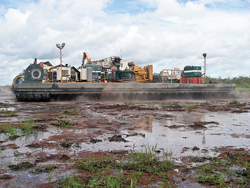 |
| The Toucan II is a 140 x 110 ft unit with a 300-ton payload built on a platform using the company’s modular steel Flexifloats, individual pontoons that join together to make up a larger platform. |
|
New Arctic drilling rig
KCA Deutag introduced its latest generation Arctic drilling rig in 2011, the HR 4000, that is winterized against the extreme cold of Siberia. The first unit presently is working in Eastern Siberia, with a second unit scheduled to begin work in Western Siberia in 2012. The small-footprint rig is designed and built for cluster pad drilling in Siberia, where the multiple wellhead configuration reduce, the high cost of building single pads.
The rig features a 146-ft vertical bootstrap style mast for rigging up in restricted locations. The rig and support modules are skiddable when drilling over a multi-wellhead pad as is typical in Siberia. The rig also features a 250-ton hookload, and is equipped with a top-drive drilling system, iron roughneck and state-of-the-art driller’s cabin.
The rig can operate in Arctic environments in a temperature range from -45°C (-113°F) to +40°C (104°F). The rig’s box-on-box design substructure is fully enclosed to the skid rails below the rig floor. Heat from the generator sets is run through a heat exchanger and pumped to the rig floor area and support modules during the winter, including the driller’s cabin, drill floor, setback area. Maximizing the use of heat-recovery systems helps reduce fuel consumption.
The rig can be skidded on a multi-well pad and includes a Bentec-designed and built skidding system for the rig and a heavy duty roller system for the support module. The rig is skidded hydraulically, and it and the support module train move simultaneously. All of the hydraulics necessary for skidding and leveling are in the box design substructure. The external pipe rack is moved independently of the rig when the rig is over the next wellhead. Skidding time is about 2.5 hours to move 5 m.
The mast is designed for storing triple stands of pipe in the setback area. The substructure is capable of supporting a setback load of 350,000 lb and a casing load of 55,000-lb. The unit features a Bentec TD-350-HT top drive system, Bentec E-1500-AC 1,250-hp drawworks, and two Wirth TPK 1,600-hp mud pumps. 
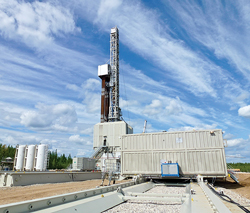 |
| KCA DEUTAG’s latest generation Arctic drilling rig, the HR 4000, can operate in Arctic environments in a temperature range from -45°C (-113°F) to +40°C (104°F). |
|
New rig design built for moderate depth land drilling
IDE (Integrated Drilling Equipment) developed the IDE Sparta Recon Drilling System (SRDS), a new AC-powered land rig designed specifically for the requirements of moderate-depth drilling. The design combines a number of key features to provide for easy setup, efficient transport and productive drilling operations.
The SRDS can be moved in hours compared with days required by conventional rigs. Only 12 loads are required to move the rig complete with an AC top drive that is transported in the mast with the traveling block and drill line spooler. The rig’s AC VFD controls and top drive design results in efficient drilling and safe drilling conditions.
The rig features a single-load substructure with telescoping doubles mast, both of which are hydraulically raised. The 1,000-hp rig mast is a freestanding design, with a 115-ft clear height, an 11-ft leg spread and 500,000-lb static hook load strung on 10 lines.
Designed to travel on the drill floor, the two-piece mast base section can be handled and raised without a crane, and includes the base section and the crown/upper section.
Transportation efficiency is enhanced due to the crown and upper section capable of being moved as a single load. The bottom sections are pinned to floor pedestals at ground level and remain on the floor during transportation.
For additional transportation efficiency, the drawworks is integrated into, and transports on, the substructure. The substructure loads and unloads itself with integrated hydraulic cylinders, which also are used to raise the substructure after the mast has been erected.
The racking board has capacity for 9,000 ft. of 4½-in. drill pipe or six stands of 6½-in. drill collars. The racking board is adjustable from 55 ft to 58 ft above the drill floor, and includes 84-in-high hand rails and an escape platform. The racking board platform is complete with a folding diving board, access catwalk, pullback win., and fold-up floor slab on the driller’s side.
In addition to the Sparta Recon drilling system, IDE is engineering a new rig, the Super 90, which is designed to deliver a higher level of automation for better drilling efficiency, safety, and speed. This new rig is expected to be completed in the second half of 2012. 
|
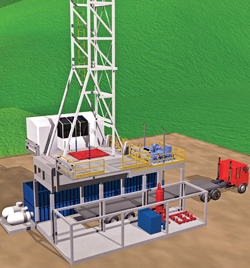
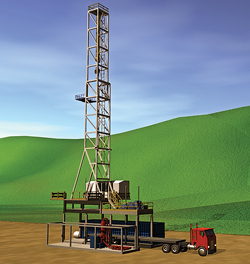
|
| IDE’s (Integrated Drilling Equipment) Sparta Recon Drilling System (SRDS), a new AC-powered land rig designed specifically for the requirements of moderate-depth drilling, can be moved in hours compared with days required by conventional rigs, requiring only 12 loads to move the rig complete with an AC top drive that is transported in the mast with the traveling block and drill line spooler. |
|
Rig designed for the Bakken
Nabors Drilling USA’s reinvented programmable A/C electric (PACE) model operates on multi-well pads in shale plays in the northern part of the US Lower 48. The re-invented rig, dubbed the B-Series, is a custom, designed box-on-box 1,500-hp unit rig specifically built for unconventional plays, particularly North Dakota’s Bakken and Three Forks formations. The company evaluated several iterations of the PACE design including self-elevating, hydraulically raised masts and substructures. Considering the extreme weather conditions and winterization required for working in the harsh winters, a box-on-box type rig became the preferred option. The customer’s well configuration necessitated turning the substructure and mast 90°, installing a walking system, changing the electrical grasshopper to a telescoping festoon, and relocating the solids-control equipment to optimize the design of the flow line. Eight B-Rigs are currently operating in North Dakota.
The rigs are equipped with a Columbia Walking System that allows the rig to move about 30 in. in 90 seconds on a pad from wellhead to wellhead. The rig can move up to 100 ft without moving the backyard and with full setback. A well-to-well move can be accomplished in as little as one hour and can return to a previously drilled well with an accuracy of plus or minus 1/16 in., according to the company.
The 20-ton blowout preventer (BOP) handling system is designed to transport the BOP stack in a single piece and to safely and quickly upright and manipulate the BOP stack at well center. It can raise the stack to vertical and position it on the wellhead without manual intervention, increasing safety and reducing costs by reducing the nipple up and down time. The single-piece BOP transport eliminates the need to break the stack down for moving and also makes cutting casing and setting wellhead spools more
efficient and safer.
The box-on-box substructure has a 25-ft floor height and 21-ft clear height under the rotary beams. The substructure is rated for 800,000 lb rotary load simultaneous with a 500,000-lb setback load. The Canrig 1250 AC top drive drilling system is powered by a single 1,150-hp AC motor with a continuous torque rating of 51,400 lb at 118 rpm. A Canrig Torq-Matic fully automated floor wrench with PLC control can be operated from the driller’s console or remotely from various rig floor locations, and can accommodate pipe from 2 3/8 in. to 8 ½ in. The climate-controlled Driller’s cabin uses joystick controls with PLC technology. The touch-screen controls rig equipment and drilling parameters.
The rig includes a Canrig automated PowerCat 3000 catwalk designed to individually index racked drill pipe, drill collars and casing into a central carrier for lifting to the drill floor. It can raise subs, casing, logging tools or utility baskets, and eliminates the need for pickup and laydown services when running casing. The remote control capability means the unit can be operated from the drill floor or from ground level. 
|
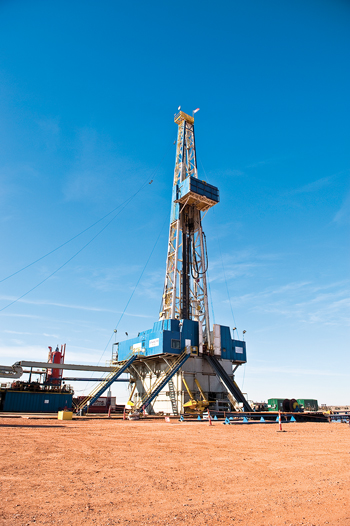
|
| Nabors Drilling USA's B-Rigs are working in the Bakken shale play in North Dakota. |
|
|







